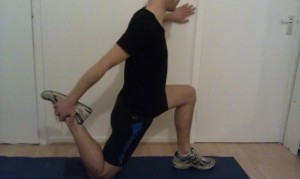The Ski season is upon us and for those intending to escape the inevitable London slush to catch some Christmas powder there are some great stretches that could stop you from stiffening up too much after a long day exercising on the slopes.
If it has been a year since you last went skiing then you will certainly feel the muscle ache after the first day on the slopes. This is normal. It is called delayed onset muscle soreness (DOMS). DOMS occurs because of the sudden increase in demand on the muscles that are not accustomed to the load, resulting in inflammation in the muscle. Unfortunately no amount of stretching can make up for the loss of muscle strength and conditioning that occurs between seasons. Training on the cross trainer can, however, help to retain some of this conditioning. If you are quite sore then be extra gentle with the stretches, you don’t want to overstretch an injured muscle!
Because of the position of the body when skiing, the main areas where you are probably going to ache are the thighs and the buttocks. This is because the hips and knees are constantly bent whilst skiing, placing a huge load on both the quadriceps and the gluteal muscles. This loading is exacerbated by the recruitment of these muscles to push the hips sideways when changing direction and because they absorb forces from the ground much like the suspension of a car does.
This can produce a burning sensation at the front of the thigh and in the buttock region as the muscles fatigue. Pain can also occur where the muscles attach at the knee or around the hip.
To stretch the gluteal muscles, lie on your back with one leg straight and the other bent at the knee.
Roll the straight leg inwards so that the toes are pointing towards the side of the bent knee.
Take hold of the bent knee with both of your hands and gently draw the knee towards the chest until a gentle pull is felt in the buttock.
Now gently draw the knee across yourself towards the opposite side of your body.
The stretch in the buttock should be much stronger now.
Hold this position for 30 seconds, release for 2 seconds and then repeat for another 30 seconds. Do 3-5 repetitions on the same side before swapping over to the other side.
Follow this with a second stretch for a different set of gluteal muscles.
Again whilst lying on your back bend up one knee.
Place the ankle of the opposite leg onto the bent up knee.
Now you are crossed legged lying on your back.
Both hands reach through to the back of the thigh on the side with the bent up knee.
The knee is drawn gently towards the chest until a stretch is felt in the opposite buttock.
Again, hold this position for 30 seconds, release for 2 seconds and then repeat for another 30 seconds. Do 3-5 repetitions on the same side before swapping over to the other side.
To stretch the quads, you will need a soft surface to kneel on such as a cushion or a stretching mat and a wall or a piece of furniture to hold onto for balance.
Take up a lunge position with one knee on the cushion and the other leg forward with the knee bent.
Holding onto the wall for balance, take hold of the foot on the side of the cushion. Do not draw the foot towards you yet.
Lunge forwards onto the front leg, pushing the hip on the kneeling side forwards at the same time.
You should now be feeling a stretch at the front of the thigh.
Now draw the foot towards you to enhance the stretch.
This is a very strong stretch so you shouldn’t need to pull too hard. If you have trouble reaching the foot, you can use a belt or a towel wrapped around the front of the foot to help you.
Again, hold this position for 30 seconds, release for 2 seconds and then repeat for another 30 seconds. Do 3-5 repetitions on the same side before swapping over to the other side.
These three stretches will keep the DOMS to a minimum and aid recovery after a long day exercising. Don’t forget to gently stretch the hamstrings and the calf muscles also as these muscles will also be getting a lot of use.
Supplements such as magnesium and zinc are great for muscle recovery and compression clothing can also help to manage the inflammation in the tissues. You can also anaesthetise the pain with a few well-earned hot whiskeys!
As with any stretch, these should not be painful during or afterwards. You should just have a stretching feeling. If you do feel pain then stop, try again more gently. If it is still painful then don’t repeat the stretch and report it to your Osteopath when you next see them.
Have fun and stay injury free!
Geoffrey Hogan (M.Ost)
Registered osteopath



